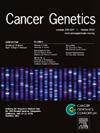42.试行 NTRK 融合特异性致癌指南:经验教训
IF 1.4
4区 医学
Q4 GENETICS & HEREDITY
引用次数: 0
摘要
涉及神经营养受体酪氨酸激酶基因(NTRK1、NTRK2、& NTRK3)的基因融合是公认的致癌驱动因素,也是癌症的重要诊断和治疗标志物。鉴于美国食品药品管理局(FDA)批准了 TRK 抑制剂(如 larotrectinib 和 entrectinib),解释其临床意义成为当务之急,但由于融合发现速度快、融合伙伴和肿瘤类型多样以及缺乏融合特异性分类规则,解释其临床意义仍具有挑战性。ClinGen NTRK融合体细胞癌变异保藏专家小组(SC-VCEP)正在应对这些挑战,并在CIViC (civicdb.org)知识库中创建公开可用的高质量临床重要NTRK融合论断,以支持患者护理。我们的NTRK融合特异性致癌指南(2022年4月获批)根据融合结构(方向/断点/读取框)、癌症关联(独特病例数)、临床有效性(靶向抑制剂反应)和功能状态(通路激活或表达)将NTRK融合分为致癌、可能致癌、意义不明(VUS)或良性。对癌症中发现的一系列常见到罕见的 NTRK 融合体应用试点指南,得出了 11 项致癌论断(6 项致癌、1 项可能致癌、4 项 VUS)、5 项诊断论断和 10 项预测论断,支持对拉罗替尼或恩替替尼的敏感性。该试点引入了几项修改,包括1)由于报告的 NTRK 阳性肿瘤很少见,因此减少了达到癌症关联性或临床有效性所需的病例数;2)进一步明确了 NTRK 融合结构;3)由于数据库有时缺乏审查,因此要求融合必须在发表的文献中报告;4)扩大了 NTRK 相关肿瘤列表。未来的工作将评估这些指南的临床实用性,并改进我们的工作流程和指南。本文章由计算机程序翻译,如有差异,请以英文原文为准。
42. Piloting NTRK fusion-specific oncogenicity guidelines: Lessons learned
Gene fusions involving neurotrophic receptor tyrosine kinase genes (NTRK1, NTRK2, & NTRK3) are well-established oncogenic drivers and important diagnostic and therapeutic markers in cancers. Interpreting their clinical significance is a high priority given FDA approval of TRK inhibitors (e.g, larotrectinib and entrectinib), but remains challenging due to rapid fusion discovery, diversity of fusion partners and tumor types, and lack of fusion-specific classification rules. The ClinGen NTRK Fusions Somatic Cancer Variant Curation Expert Panel (SC-VCEP) is addressing these challenges and creating publicly available high-quality clinically significant NTRK fusion assertions in the CIViC (civicdb.org) knowledgebase to support patient care.
Our NTRK fusion-specific oncogenicity guidelines (approved April 2022) classify NTRK fusions as Oncogenic, Likely Oncogenic, Unknown Significance (VUS), or Benign based on Fusion Structure (orientation/breakpoints/reading frame), Cancer Association (number of unique cases), Clinical Validity (targeted inhibitor response), and Functional Status (pathway activation or expression). Pilot guideline application to a range of common to rare NTRK fusions found in cancers resulted in 11 Oncogenic Assertions (6 Oncogenic, 1 Likely Oncogenic, 4 VUS), 5 Diagnostic Assertions, and 10 Predictive Assertions supporting sensitivity to larotrectinib or entrectinib. This pilot introduced several modifications including: 1) reducing case number required to reach cancer association or clinical validity due to the rarity of reported NTRK-positive tumors; 2) further clarifying NTRK fusion structure; 3) requiring fusions to be reported in the published literature, as databases sometimes lack vetting; 4) expanding the NTRK-associated tumor list. Future efforts will evaluate the clinical utility of these guidelines and improve our workflows and guidance.
求助全文
通过发布文献求助,成功后即可免费获取论文全文。
去求助
来源期刊

Cancer Genetics
ONCOLOGY-GENETICS & HEREDITY
CiteScore
3.20
自引率
5.30%
发文量
167
审稿时长
27 days
期刊介绍:
The aim of Cancer Genetics is to publish high quality scientific papers on the cellular, genetic and molecular aspects of cancer, including cancer predisposition and clinical diagnostic applications. Specific areas of interest include descriptions of new chromosomal, molecular or epigenetic alterations in benign and malignant diseases; novel laboratory approaches for identification and characterization of chromosomal rearrangements or genomic alterations in cancer cells; correlation of genetic changes with pathology and clinical presentation; and the molecular genetics of cancer predisposition. To reach a basic science and clinical multidisciplinary audience, we welcome original full-length articles, reviews, meeting summaries, brief reports, and letters to the editor.
 求助内容:
求助内容: 应助结果提醒方式:
应助结果提醒方式:


